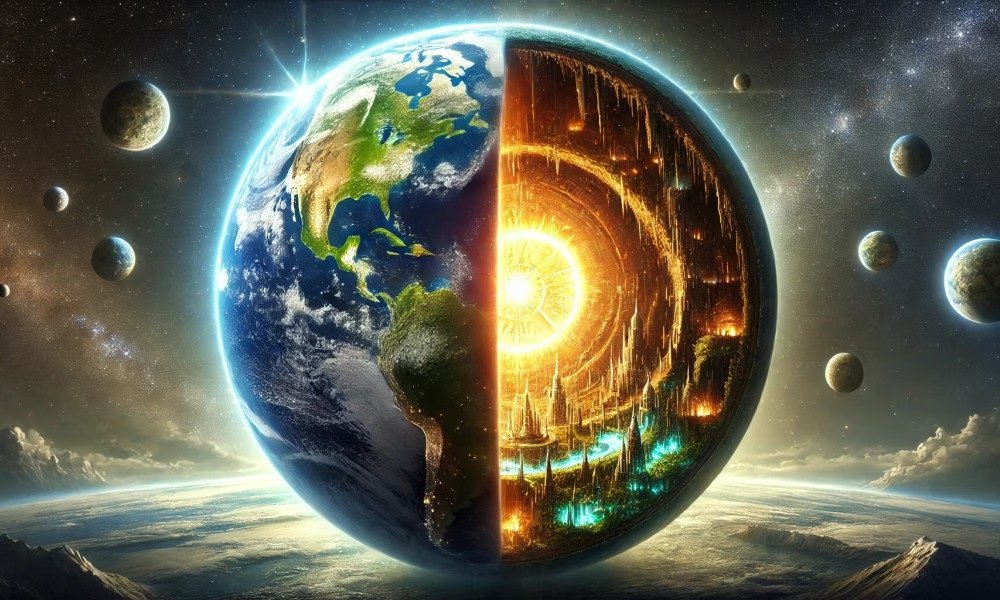
Throughout history, the idea that our planet might be hollow—and perhaps even inhabited inside—has captured the imagination of adventurers, mystics, and conspiracy theorists alike. Known as the Hollow Earth Theory, this concept stands as one of the more outlandish and enduring claims in the realm of pseudoscience.
The Origins of the Hollow Earth Concept
The notion that the Earth could be hollow has ancient roots. Various mythologies from cultures around the world reference subterranean realms—whether it be the Greek underworld, Buddhist Shambhala, or Native American stories of inner-earth ancestors. But it wasn’t until the late 17th century that the theory took on a scientific veneer.
In 1692, Edmond Halley, best known for Halley’s Comet, proposed a hollow Earth model to explain anomalies in Earth’s magnetic field. Halley speculated that Earth consisted of a series of nested spherical shells, each with its own atmosphere and magnetic properties. Though Halley was respected in the scientific community, his hollow Earth idea was largely speculative and eventually dismissed by more rigorous geological studies.
Hollow Earth in the 19th Century: Fiction Meets Fantasy
The 19th century saw a resurgence of interest in the theory, driven less by science and more by literature and adventure tales. John Cleves Symmes Jr., an American army officer, took Halley’s concept a step further. In 1818, Symmes publicly declared his belief that the Earth was hollow and accessible via massive openings at the poles—now called “Symmes Holes.” He even petitioned Congress to fund an expedition to find these polar entrances.
While his ideas were widely ridiculed, they inspired further popular interest, including fictional accounts like Jules Verne’s Journey to the Center of the Earth (1864). Though intended as fantasy, Verne’s work further cemented the hollow Earth myth in the public consciousness.
Twentieth-Century Variants: Nazis, UFOs, and Inner Earth Civilizations
As the 20th century progressed, the Hollow Earth Theory was adopted by increasingly fringe movements. Some claimed that advanced civilizations, like the mythical Agartha, existed inside the Earth and were populated by highly evolved beings. Others tied the theory to conspiracy lore involving Nazi Germany, alleging that high-ranking Nazis had escaped to secret underground bases accessible through the poles.
Later, some UFO enthusiasts blended the Hollow Earth theory with extraterrestrial beliefs, claiming that alien spacecraft might originate not from outer space, but from inner space—the hidden world beneath our feet.
Scientific Reality: Solid Evidence Against a Hollow Earth
Despite its continued popularity in certain circles, the Hollow Earth theory has no scientific support. Seismology, the study of how earthquake waves move through the planet, has provided clear evidence that Earth has a solid crust, a viscous mantle, a liquid outer core, and a solid inner core.
In fact, seismic waves behave differently depending on the material they pass through. Scientists have used this data to create accurate models of Earth’s internal structure—none of which include hollow cavities or subterranean civilizations.
Furthermore, gravity measurements, magnetic field analysis, and direct geological studies all support the model of a solid Earth. The idea of massive polar openings or internal suns simply doesn’t hold up under scrutiny.
Why Do People Still Believe It?
As with many pseudoscientific beliefs, the Hollow Earth theory persists because it offers mystery, adventure, and a sense of hidden knowledge. It also plays into a deep human fascination with unexplored worlds and forbidden truths.
In the age of the internet, such ideas can spread rapidly, reinforced by videos, forums, and pseudo-documentaries. For some, believing in hollow Earth is more about questioning mainstream science and authority than genuinely seeking empirical evidence.
Conclusion
The Hollow Earth Theory is a fascinating relic of scientific speculation and literary imagination, but it remains firmly in the realm of pseudoscience. While it may never disappear from popular culture, our understanding of the planet’s structure has advanced far beyond this hollow hypothesis.




